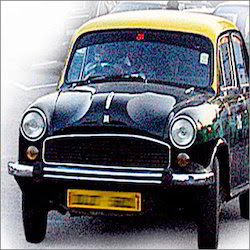Do Mumbai Roads yet have space for 'Kaali-Peeli' taxis?
Home to the personal residential tower of
Mukesh Ambani, chairman of Reliance industries Limited, located in South
Mumbai, Antilia is the most expensive home in the world. Similarly Mumbai has
most of the high-rise buildings in India with the eighteenth highest number of
skyscrapers in the world.
However, this financial capital relies on
road transport and a significant portion of that is the taxi service. The
vehicles (down below) have undergone a complete transformation from what they
were before.
Familiar with those ‘kaali-peeli’ cabs that
trudge along the road and honk their horns every now and then? One thing is
certain and that is that the role of taxis has never been as important as is
now!
These cabs were actually introduced to
Mumbai in 1911 to complement horse wagons and they form a very integral part of
the city’s heritage. They also have been depicted in Bollywood movies. They
were actually named after a legendary Indian Queen Padmini. These taxis were
synonymous with Mumbai for half a century and in the middle of the 20th
century you could find 65,000 Padmini’s on the road.
What’s
so special about them?
Compact black and yellow cabs, these
Italian fiats boasted of elaborate patterned interiors! It is without doubt one
of the most iconic cars because they have been in existence for so long and
have constantly prowled the roads searching for customers. It could perhaps
have been the largest fleet of vehicles in the world!
So while they were initially known as ‘Fiat
taxis’, they later on were renamed to Padmini in 1973 after a queen Rani
Padmini who lived during the 13th and 14th centuries. Many
of them have colourful-carpeted ceilings and seat covers and even boast of
bright multi coloured neon lights that illuminate inside the car at night.
It was in 2013, when the death knell was
finally sounded for Padmini’s. The government had implemented an antipollution
order banning cars that were more that 20 years old from plying on Mumbai’s
roads. Since then the number of Padmini’s has rapidly declined and it is
estimated that there will be more at stake for Padmini’s crisis in the future.
In a world, where taxis have been a common mode
of transport, taking people from one point to the other, the use of smartphones
has considerably taken over this world through many ride-hailing services.
There is an urgent requirement and need for
modern cars that use new technology. This is also in conjunction with the
popularity of ‘app-based cab’ whereby a person can book a taxi via an app. The main
taxi-booking apps in India are Ola Cabs, Uber and Meru Cabs.
Ola Cabs: Known to be the biggest
ride-sharing company in India, Ola was founded in 2010 by Bhavish Aggarwal and
Ankit Bhatia in Mumbai. Interestingly, it has now shifted its headquarters to Bangalore.
The company is worth more than $3billion with Softbank being the main investor.
Uber: Founded by Garrett Camp in 2009 –the
co-founder of StumbleUpon and Travis Kalanick, Uber was initially known as
UberCab in San Francisco.
Four years later in August – 2013, the
first Uber ride took place in India (Bangalore)! Back then; it was already
operating in 19 countries around the world. It is one of the most popular and
successful startups in the world.
Who wouldn’t want to have a simpler way to travel?
Its all about convenience and comfort and
that's just what has changed the mentality of people. To book a cab, all you
need to do is press a button on a smartphone (another added bonus of the SMART
times that we live in!).
Besides that, one of the major reasons many
people opt for these modes of transport (Ola, Uber, share autos) is because of
the long wait at bus stops.
Within a few minutes you can get your
taxi-driver who will pick you up from your doorstep and drop you right off at
the exact location. It’s easy to make payments, as there are multiple options-
PayTM, debit card or cash.
In addition to this, Uber has also tied up
with ‘Kaali-peeli’ drivers in SoBo, from Colaba to Worli areas enabling these
cabs to also join the app platform
and to provide rides to customers at normal RTO rates. However, this network is
yet being built.
In addition to this, this year Prafulla
Shinde-the founder & director of S3 cabs launched Sahyadri Smart Safe Cabs
(S3 cabs). These cabs are known to offer rides free of surge pricing and at
rates that are cheaper than existing competitors.
He also added that there would be no surge
or night charges and the cabs would be booked at a fixed rate of INR 10-12 per
km (which is less than all the other competitors).
Already, media statements have reported
that approximately 800 tourist cab drivers have registered on the S3 platform and
4,0000 other applicants are currently being processed!!! To read more about it you can visit this link-
http://bit.ly/2vPu602
What is the future of transport in Mumbai? There’s
a space for every type of service, but who is going to surge ahead and leave
behind the others?
Food for Thought: Ola has even started its
services in Sydney Australia. Does this show that Indian start-ups can capture
global markets and survive in developed countries? https://nyti.ms/2nIc1fJ







Comments
Post a Comment